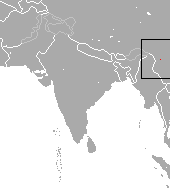
Mesotardigrada is one of three classes of tardigrades, consisting of a single species, Thermozodium esakii. The animal reportedly has six claws of equal length at each foot. This species was described in 1937 by German zoologist Gilbert Rahm from a hot spring near Nagasaki, Japan. The inability of taxonomists to replicate Rahm's finding has cast doubt on the accuracy of the description, making T. esakii, and by extension the entire class Mesotardigrada, a taxon inquirendum.

Romance of the Three Kingdoms is a Chinese television series adapted from the classical 14th century novel of the same title by Luo Guanzhong. The series was produced by China Central Television (CCTV) and was first aired on the network in 1994. It spanned a total of 84 episodes, each approximately 45 minutes long. One of the most expensive television series produced at the time, the project cost 170 million yuan. It was completed over four years and involved over 400,000 cast and crew members, including divisions of the People's Liberation Army from the Beijing, Nanjing and Chengdu military regions. Some of the dialogue spoken by characters was adapted directly from the novel. Extensive battle scenes, such as the battles of Guandu, Red Cliffs and Xiaoting, were also live-acted.
Sinocyclocheilus is a genus of freshwater fish in the family Cyprinidae that is endemic to Guangxi, Guizhou and Yunnan in China. Almost all of its species live in or around caves and most of these have adaptions typical of cavefish such as a lack of scales, lack of pigmentation and reduced eyes. Several species have an unusual hunchbacked appearance and some of the cave-dwellers have a "horn" on the back, the function of which is unclear. In contrast, the Sinocyclocheilus species that live aboveground, as well as a few found underground, show no clear cavefish adaptions. They are relatively small fish reaching up to 23 cm (9.1 in) in length. The individual species have small ranges and populations, leading to the status of most of the evaluated species as threatened. Many species populations in the genus have yet to be evaluated by the IUCN.

Epomophorus is a genus of bat in the family Pteropodidae. They have a distribution throughout Africa.

Nyctimene is a genus of bats in the Pteropodidae family. Commonly known as tube-nosed fruit bats, they are found in the central Philippines, eastern Indonesia, Papua New Guinea and the north-east coast of Australia.
Eprhopalotus is a genus of hymenopteran insects of the family Eulophidae. Their distribution varies between species but ranges from Costa Rica, Mexico to Texas. There are currently 5 species of Eprhopalotus:
Aacocrinus is a genus of extinct sea lily from the Actinocrinitidae family. There are currently 14 species within this genus:

Aades is a genus of beetles in the family Curculionidae, commonly known as weevils. These insects are found in various parts of the world, including North and South America, Asia, and Europe. They are generally small in size, with most species measuring between 2 and 7 millimeters in length.
Aagaardia is a genus of fly in the Chironomidae family. Aagaardia has been found in Finland, the mainland of Norway and Russia.
Aaglacrinus is an extinct genus of crinoidea in the Cladia order. It has been proposed that it was a stationary (attached) suspension feeder the hard parts of which were composed of magnesium calcite.
Aglaocrinus is an extinct species of crinoids in the Cladia order. It has been proposed that it was a blind, stationary (attached) suspension feeder the hard parts of which were composed of magnesium calcite. It has been discovered in 3 locations in North America.

Anagyrus is a large genus of parasitic wasps from the family Encyrtidae. Anagyrus is distributed throughout the world. A subgenus of Anagyrus is known as Nesoanagyrus
Chodsigoa is a genus of shrews in the tribe Nectogalini.

Van Sung's shrew, also known as Cao Van Sung mountain shrew is a species of shrew in the Soricomorpha order. Specimens of Chodsigoa caovansunga have been found in Vietnam.

The pygmy brown-toothed shrew is a species of shrew in the order Eulipotyphla. It is distributed in China. C. parva was initially thought to be the same as Chodsigoa lamula, but it was found to be a separate species.

Raoultella planticola is a Gram-negative bacterium of the genus Raoultella. R. planticola is quite similar in appearance to Klebsiella pneumoniae and must be identified based on growth habits or DNA analysis. A number of strains have been identified.
Episoriculus is a genus of shrew in the red-toothed shrew subfamily. Its common is brown-toothed shrew. It has been described as a subgenus to Soriculus in the past. The genus occurs at a number of locations in Asia, including Nepal and China.

Caryanda is a large genus of grasshoppers in the subfamily Caryandinae. Species are recorded from Africa and Asia.
Paratettix curtipennis is a species of groundhopper which belongs to the subfamily Tetriginae and tribe Tetrigini. Its distribution includes: India, southern China, including Tawan, Indo-China and peninsular Malaysia; no subspecies are listed in the Catalogue of Life or the Orthoptera Species File.









